What Is Dash?

Dash (DASH) is a next-generation digital currency based on the Bitcoin software.
Dash has solved many of the problems inherent in Bitcoin by speeding up transactions, offering enhanced financial privacy, and developing a decentralized governance and funding system.
Why Choose Dash?
- PRIVATE
Keep your payments private so nobody can track you, your transactions and balances are nobody’s business. With Dash’s ahead- of- time anonymization, only you have access to your financial information.
- INSTANT
Dash harnesses the power of its Masternode network to power an innovative technology called InstantX. When sending money, users can select the “Use InstantX” box in their wallet, and transactions will be fully sent and irreversible within four seconds.
- SECURE
Advanced encryption and a trustless protocol for complete security in your payments and anonymization process.
- GLOBAL
You can send money anywhere in the world with the same low fees and the same speed as if you were sending money next door!
- LOW - FEES
Most transactions only cost a few cents to send, which is considerably cheaper than services like Western Union, PayPal, or Moneygram.
- HOW TO GET A DASH DEBIT CARD
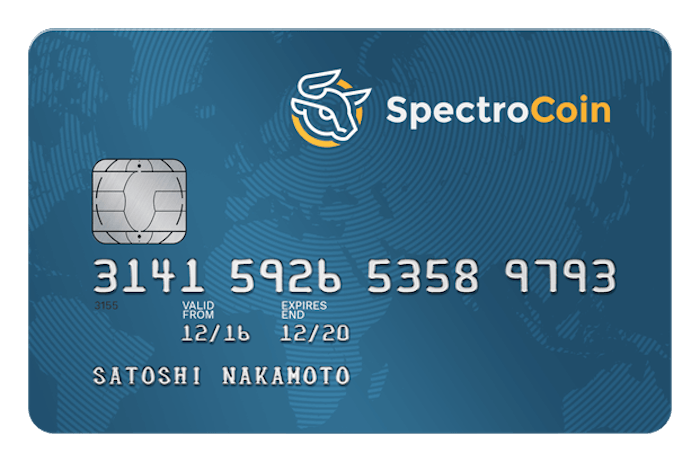
SpectroCoin offers Bitcoin prepaid cards, which can be used at any ATM around the globe or shops as an ordinary payment card.
The SpectroCoin VISA Debit Card is funded instantly, so you do not have to worry about exchanging your bitcoins in advance.
The card can be denominated in dollars (USD), euros (EUR) or pounds (GBP).
Pay with bitcoins wherever you want. SpectroCoin bitcoin debit card is accepted everywhere where MasterCard or VISA is accepted. That includes automated teller machines (ATMs) for cash withdrawal, online sites, and physical shops. This Bitcoin debit card can also be linked to PayPal or any other online wallet.
- Overview - Table of Contents
- What Is Dash?
- Getting Started With Dash
- How To Get A Dash Wallet?
- Dash Resources
- How To Buy Dash?
- How To Earn Dash?
- Where To Spend Dash?
- What Is Dash Mining?
- Latest Dash News
Virtual and physical bitcoin debit cards are available. Virtual bitcoin cards are issued instantly and can be used to spend bitcoins anywhere online. Physical bitcoin cards are delivered within 1-4 weeks and can be used to spend bitcoins anywhere physically and online.
Instant loading. Bitcoin debit cards can be loaded immediately from SpectroCoin wallet.
No verification required. To simplify the process, you are not obliged to complete verification immediately. However, to benefit from higher debit card limits, you will have to verify your account.
Cards in several currencies are available. USD (dollar), EUR (euro) and GBP (pound) cards are issued.
Multiple digital currencies this debit card can be funded with various digital currencies including Bitcoin, DASH and more.
Low fees are guaranteed for SpectroCoin bitcoin debit card holders. The dollar, euro or pound denominated debit card costs 9 USD/8 EUR/6 GBP respectively. There is also no loading fee.
Unlimited lifetime withdrawals and deposits to the bitcoin debit card for verified cardholders. Other limits also being high.
- PEER- TO- PEER
Like bittorrent, Dash is a fully decentralized peer-to-peer (P2P) network. Because of this, you don’t have to trust a bank or other centralized service. Everything stays between you and the other party in the transaction.
- MASTERNODES AND PROOF-OF-SERVICE
In addition to traditional Proof- of- Work (PoW) rewards for mining Dash, users are also rewarded for running and maintaining special servers called “Masternodes”.
What are Masternodes?
Simply put, Masternodes provide much of the necessary infrastructure to the Dash network. Most people are familiar with the single-tier network that Bitcoin utilizes. Users broadcast transactions to the network, and when miners discover a new block, they incorporate all those transactions into the blockchain.
Each block that is added to the blockchain is considered one “confirmation,” but transactions are not considered to be fully “cleared” and irreversible until they receive at least six confirmations. With an average blocktime of ten minutes, Bitcoin transactions take about an hour to fully confirm!
Dash takes things a step further by utilizing a two-tier network. The first tier works in the same way as Bitcoin: miners find blocks and post transactions to the blockchain. The second tier, comprised of special servers called Masternodes, enables additional features such as instant transactions (InstantX), private transactions (Darksend), and decentralized governance and budgeting.
Anyone can run a Masternode, but in order to do so, the user must prove that they own 1000 DASH. This is to prevent so-called “Sybil attacks” on the network. The 1000 DASH is not locked or consumed--a Masternode owner can spend that 1000 DASH anytime he/she wants, but doing so will result in the Masternode turning itself off. Masternodes are typically hosted on virtual private servers (VPS) run by companies such as Amazon Web Services, Microsoft Azure, Vultr, and others.
People are incentivized to run Masternodes because they receive a portion of the reward when miners find new blocks (45% of the block reward goes to miners, 45% goes to Masternodes, and 10% is used to fund Dash-related projects via the decentralized budget system). The return on investment is currently about 15% (over the course of a year, you will earn approximately 150 DASH from running a Masternode).
At the time of this writing, there are 3400 Masternodes in 22 different countries. This provides a high level of decentralization due to the impossibility of one user gaining control of enough Masternodes to deanonymize transactions.
X11 Chained Hashing Algorithm
X11 is a widely used hashing algorithm created by Dash lead developer Evan Duffield. X11’s chained hashing algorithm utilizes a sequence of eleven hashing algorithms for the proof-of-work. This is designed to increase the decentralization level of the currency by making ASICs difficult to develop.
The crypto community has seen the increasing levels of centralization within Bitcoin that have come about since Bitcoin ASICs were implemented and Dash is trying to avoid that. Another benefit of the X11 algorithm is that GPUs require approximately 30% less wattage and run 30-50% cooler than they do with Litecoin’s Scrypt algorithm.
What is DarkSend?
The Dash client stores pre-mixed, denominated Dashs in the user’s wallet, to be used instantly at any time the user desires. The mixing and denomination process is seamless, automatic, and requires no intervention on the part of the user. Here’s how it works:
Every 10 blocks, all user clients network-wide will send any unmixed, Dash in their possession through an anonymization phase. In this phase, Masternodes are used in chained succession to mix the coins they receive from the network and break them down into homogenous denominations. After being processed by a minimum of two Masternodes, the coins are either sent to the next Masternode in the chain or back to the user’s wallet at randomly generated change addresses.
Please note that at no point in the process do a user’s coins ever leave his/her control. They will be sent to different addresses within the wallet, but they never leave the user’s possession.
- Overview - Table of Contents
- What Is Dash?
- Getting Started With Dash
- How To Get A Dash Wallet?
- Dash Resources
- How To Buy Dash?
- How To Earn Dash?
- Where To Spend Dash?
- What Is Dash Mining?
- Latest Dash News
Depending on the desired level of privacy, users may select between two and eight “rounds” of mixing. The desired mixing depth can be selected in the client GUI.
At the end of the anonymization phase, the user’s coins are returned to their client at a randomly generated change addresses. When the user wishes to make a transaction, the client forwards the intended amount from these anonymous change addresses directly to the intended receiver’s address.
Getting Started With Dash
What is Decentralized Governance by Blockchain?
Dash has developed a decentralized system to govern and fund the future development of the project. Anybody can come up with a project to help develop the Dash ecosystem and submit it to the network. The proposal will then be voted on by Masternode owners and if approved by at least 10% of the network’s Masternodes, the proposal will be considered approved.
In the meantime, every time a miner solves a block, 45% of the block reward goes to the miner and 45% goes to support the second tier of the network. Ten percent of the block reward is not created at that time--it is withheld by the Dash network. Once a month the DASH that was withheld is created by “superblocks.” These blocks, one per approved proposal, create the DASH needed to pay the proposals. Dash’s emission rate doesn’t change, since the same amount of DASH is created as would otherwise have been.
- Step 1: Get A DASH Wallet.
- Step 2: Get Some DASH.
- Step 3: Use Your DASH.
- Step 4: Stay Up-to-Date.
What is InstantX?
InstantX stands for “instant transactions” and is the technology that allows for transactions to be fully confirmed in only four seconds. InstantX uses the second tier of the Dash network (Masternodes) to produce a “lock” once a transaction is created on the network. The DASH involved in that transaction are locked and cannot be double-spent; the network will reject any attempts to spend the locked DASH again.
Dash Advantages
Low Expense
With Dash expenses are much lower than banks or Visas; regularly even there is no expense – you don't get charged a ton to utilize your own cash and you can send miniaturized scale installments anyplace on the planet.
Instant Payments
While quick with respect to bank exchanges, Bitcoin and most other advanced monetary standards set aside a lot of opportunity to affirm exchanges on their system. On account of Bitcoin, it takes a normal of 10 minutes to affirm an exchange and numerous traders require 5-6 affirmations before considering the exchange finish.
While this 50-hour long exchange time might be satisfactory for making installments on the web (where merchandise may not be sent for quite a long time), this makes about every single computerized cash illogical for things like up close and personal or in-store buys and could restrain their potential.
The engineers of Dash made an exceptional, decentralized innovation called InstantX that certifications and affirms installments in around four seconds. It's hard to believe, but it's true—you can send cash to wherever on the planet in just a couple of moments!
Expanded Privacy
Digital forms of money utilize an open record where anybody can check exchanges as they happen. General society record idea is truly imperative – the certainty, individuals have in the framework, originates from the way that everyone on the system goes about as a reviewer to confirm that the framework is working accurately.
Advanced monetary forms like Bitcoin, individuals send and get cash utilizing "open keys" or "locations". These addresses comprise of a series of characters and resemble this:
XrEgRgW6JkrsY38QGV65rnmKBRZ7KSRktv
While clients don't utilize their name (this is known as a pseudonymous framework), after some time numerous sellers, trades, administrations, and people that clients execute with can append your own data to your address.
Once your character has been related with your address, that important data can be utilized to track your pay, spending, and other exchange exercises, or even sold to others, for example, advertisers, culprits, charge specialists, law implementation, or notwithstanding snooping relatives. In the event that you send cash to anybody, that individual or substance can connect you with your whole exchange history.
Dash sees budgetary protection as a major right. Subsequently, Dash made a possibility for clients to make exchanges with genuine protection, so no one would ever connect a man's character with a specific address or exchange. With Dash, clients can keep every one of their exchanges private.
Two-Tier Network
Dash is the principal digital money to present the idea of "masternodes." These are servers associated with the Dash organize that are "dependably on," secure, and equipped for conveying various administrations to the system. Today, these servers are utilized to empower the protection highlights and moment exchanges we've just talked about.
Later on, they can be utilized to acquaint new administrations with the system that other digital forms of money can't convey. This two-level system additionally guarantees that Dash remains an exceptionally hearty framework with that gives an abnormal state of administration to its clients.
Very much Defined Governance Model
Great administration and administration of a crypo-cash venture is imperative to everybody, even the individuals who are not actually slanted. For instance, in spite of being the most prevalent and best-financed digital currency, Bitcoin is totally reliant on willful commitments from private industry and foundations.
This has left Bitcoin powerless against the impulses of these organizations for proceeded with help. Also, genuine differences among its engineers about specialized parts of Bitcoin's answer do not have a very much characterized way to determination, prompting worry in the media over the task's heading and capacity to beat question.
Interestingly, Dash has a very much characterized set of instruments for anybody to submit recommendations to the system to enhance Dash, get endorsement, and store those proposition straightforwardly from the system's income. This is critical to end-clients for a few reasons. To start with, it guarantees that Dash is free from the impacts of key promoters and can concentrate on conveying its center mission to its clients.
Second, it gives a way to determine disagreements about the future advancement of the innovation, which guarantees coherence of the system's administrations. Third, it empowers every meriting venture or enhancements the chance to be subsidized, regardless of the possibility that the advantages are generally spread over the system. We trust the Dash administration instruments will at last advantage its clients by conveying a predominant arrangement.
Shared
As of not long ago, you were absolutely subject to banks to exchange your assets. They have the ability to obstruct your record, debase, or even appropriate your cash. Presently you have a decision – with Dash every one of your assets are controlled by your own wallet and all cash exchanges are controlled and confirmed by a conveyed arrange. The decentralized system of clients worldwide disposes of the requirement for delegates and their charges.
Security
Dash is your very own computerized money ensured utilizing propelled cryptography. Exchanges are prepared not by a bank, but rather by the conveyed energy of thousands of free PCs everywhere throughout the world.
- Overview - Table of Contents
- What Is Dash?
- Getting Started With Dash
- How To Get A Dash Wallet?
- Dash Resources
- How To Buy Dash?
- How To Earn Dash?
- Where To Spend Dash?
- What Is Dash Mining?
- Latest Dash News
Dash works on a protected, decentralized system and its essential leverage is the two-level engineering of its system. Dash's source code is open and accessible to be seen and verified by anybody. This ensures the autonomy, wellbeing, and security of the framework. The Dash organize uses its two-level structure and propelled encryption to keep up full security of clients' assets.
Worldwide Infrastructure and Payments
You can exchange cash anyplace, to any individual who has a Dash wallet. These exchanges can't be followed or hindered by outsiders.
Less demanding International Trade
Computerized monetary standards comprehend numerous wasteful aspects in the budgetary framework, for example, encouraging global cash exchanges and electronic installments for little sums (for which Visas are wire exchanges are restrictively costly). Computerized monetary standards unite individuals in a world that is quickly cutting separations and takes into consideration more worldwide collaboration free of a man's area or neighborhood cash.
Since expenses are low or non-existent, it empowers the exchange of smaller scale installments for administrations that would somehow or another have neither rhyme nor reason utilizing higher-cost cash exchange frameworks.
New Business Opportunities
Advanced monetary standards like Dash are opening another universe of business openings and is essential to be comfortable with this innovation.
Much the same as with the ascent of the web and systems administration innovations, the improvement of overall advanced monetary standards opens up numerous open doors either to give administrations and foundation straightforwardly identified with Dash or just to be comfortable with the way it works and offer it as an esteem added alternative to clients in any customary business.
Dash specifically is a pioneer in digital currency development, being the first to work in security highlights, momentary exchanges, and various other imaginative highlights. We trust it is essential to be acquainted with the innovation, hold some computerized money, figure out the fact that it is so natural to utilize a wallet to send and get cash, and with next to no exertion new thoughts will come up about how to apply this new energizing innovation to your everyday life.
Early Adopter Advantage: Investment Potential
Dash's future looks encouraging and the Dash organize gives many highlights which are extremely valuable for individuals around the globe. Being an early adopter offers ascend to the likelihood that your Dash property could develop in an incentive after some time. There is, obviously, dependably a danger of value changes, yet Dash has turned out to be extremely steady when contrasted with other cryptographic forms of money.
How To Get A Dash Wallet?
Guide for Dash Wallet in Windows
Guide for Dash Wallet in Mac
Guide for Dash Wallet in Linux
Guide for Dash in Electrum Wallet
Link : https://electrum.dash.org/
The Electrum-Dash client focuses on speed, with low resource usage and a simple interface. Startup times are almost instant because it operates in conjunction with high-performance servers that handle the most complicated parts of the Dash system.
Electrum-Dash is a lightweight Wallet, so you do not need to download or sync the blockchain. This speeds up use of the wallet significantly, but it is missing many key Dash features available in Dash Core. The following features are not available:
- PrivateSend
- InstantSend
- Masternode control
- Voting
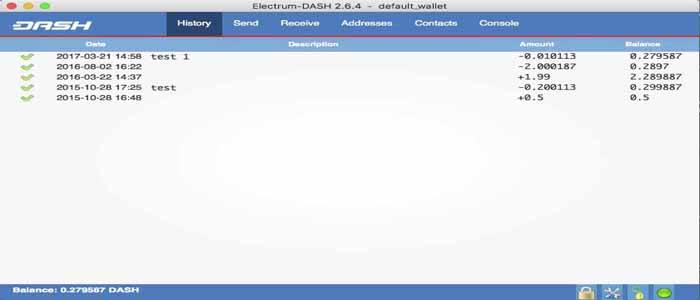
WARNING: Please only download from the official Electrum-Dash page.
Mac installation:
Windows installation:
Download and run the file labeled "Windows Executable".
Linux installation:
Download the file labeled "Linux Source Tarball".
In the terminal, run the following commands:
sudo apt install python-pip python-qt4 libusb-1.0-0-dev libudev-dev
pip install ./Downloads/electrum-dash-2.6.4.tar.gz
electrum-dash
You may own Dash stored in another software wallet, or on an exchange such as Bittrex or Kraken, or simply want to receive funds as a wage or business transaction. Funds can be transferred from these source into the Electrum wallet through one of its receiving addresses.
You can view your receiving addresses by clicking the Receive tab. Double-click the Receiving address, then copy it to the clipboard by clicking the Copy to clipboard icon. If you intend to use the address repeatedly, you can also enter a description click Save to store the address in the Requests list. Clicking an address in the list will display the stored information in the top area, together with a QR code containing the same information.
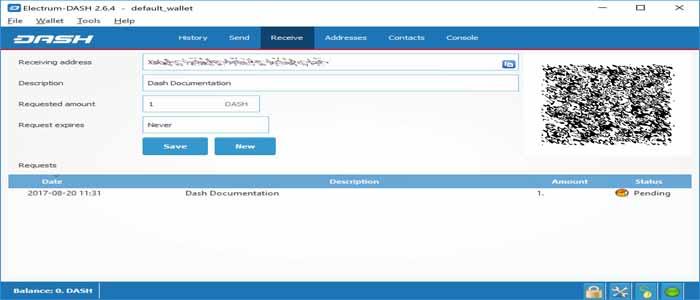
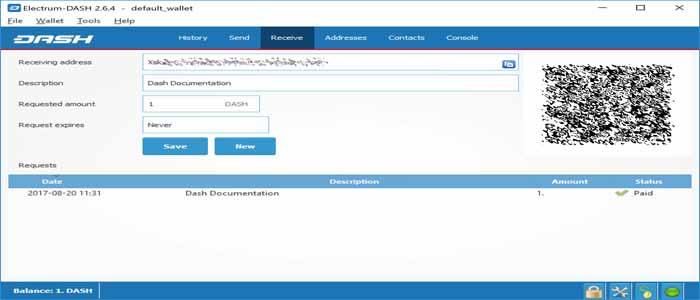
Mobile Wallets
Dash offers a standalone wallet for Android, with development supported by the Dash budget. It is designed to securely implement the latest features. Several third-party apps also support Dash.- Atomic DASH Wallet
- Dash Wallet
- Jaxx on Android
- Coinomi
- iOS Wallet
- Dash Wallet by Dash Foundation
- Jaxx on iOS
Hardware Wallets
- TREZOR
- KeepKey
- Ledger
See below the comparison:
Dash Resources
Masternode Guides:
Masternode Services (Hosting / Pooling / ....):
https://dashpay.atlassian.net/wiki/pages/viewpage.action?pageId=1867885
Whitepapers
DRK: http://www.darkcoin.io/downloads/DarkcoinWhitepaper.pdf
Dash: https://www.dash.org/wp-content/uploads/2015/04/Dash-WhitepaperV1.pdf
Translations: https://github.com/dashpay/dash/wiki/Whitepaper
Website
Block Explorer / Crawler:
Full Official Page listing:
https://dashpay.atlassian.net/wiki/pages/viewpage.action?pageId=13795346
DOWNLOADS
Walletgenerator.net - Paper Wallet
How To Buy Dash?
Buy Dash with a Wire Transfer
BitPanda – Allows you to buy Dash using your credit card, Skrill account, SEPA transfer or SOFORT transfer. Buying on Bitpanda requires verification and buying limits are relatively low (600 euros). BitPanda is available in Europe only.
Kraken – Another well respected altcoin exchange. Kraken allows you to fund your account with USD or EUR through a wire transfer and then buy Dash directly.
- Overview - Table of Contents
- What Is Dash?
- Getting Started With Dash
- How To Get A Dash Wallet?
- Dash Resources
- How To Buy Dash?
- How To Earn Dash?
- Where To Spend Dash?
- What Is Dash Mining?
- Latest Dash News
AnyCoinDirect – A website that makes it relatively easy to purchase Dash directly through a SEPA transfer for customers who are located in Europe. They are the biggest cryptocurrency exchange in Europe and their fees aren’t overly expensive. After being verified, it takes about 2 days to receive Dash.
Buy Dash Directly with Cash
Dash ATMs – There are three areas in the United States, in Oregon, Florida, and New York, where clients can purchase Dash straightforwardly from an ATM. While the expenses are high, this is one of the most effortless approaches to secure Dash. ATM areas to buy BTC and different digital currencies can be found at CoinATMRadar.
WallofCoins – Users can purchase Dash at close spot cost by basically keeping money at a nearby bank in numerous nations like the United States. Furthermore, WallofCoins is accessible in Canada, Brazil, Germany, Latvia, Poland, and the Philippines.
A talk with client bolster uncovered that they can offer Dash at almost the going business sector rate, as they are an escrow benefit, basically holding a vender's coins for them. By offering this escrow benefit, they can encourage a fiat to digital money exchange moderately modestly and send Dash straightforwardly to purchasers rapidly.
After money store confirmation, it takes around 15 minutes to get Dash. All things considered, individuals who need to buy Dash straightforwardly with money can do as such for around a 1% charge, while abstaining from purchasing Bitcoin first. It ought to be noticed that individuals who need to buy Bitcoin, can likewise do as such at WallofCoins, rearranging the way toward buying digital money generously.
Exchange Bitcoin For Dash
If you’ve already purchased Bitcoin, moving it to one of the main exchanges like ShapeShift, Changelly, Kraken, Poloniex, or Bitfinex allows one to easily trade Bitcoin for Dash.How To Earn Dash?
Passive Income Using Dash Masternode on Raspberry Pi
Why would you want to earn passive income as a Dash Masternode?
First, one can get up and running with just a Raspberry Pi (also in a dedicated server or in a VPS), which is small and inexpensive. Second, the return-on-investment (ROI) is currently estimated at 17 % per year.
The Dash blockchain has set itself apart as the world’s only currency to incentive its nodes with regular payment. Masternodes earn 47.5 % of the Dash block reward, which puts their earnings on par with Dash’s miners.
With some initial collateral and around US$50 to invest in hardware, you too can join the savvy group of earners running a Dash Masternode on a Raspberry Pi.
Pi Time
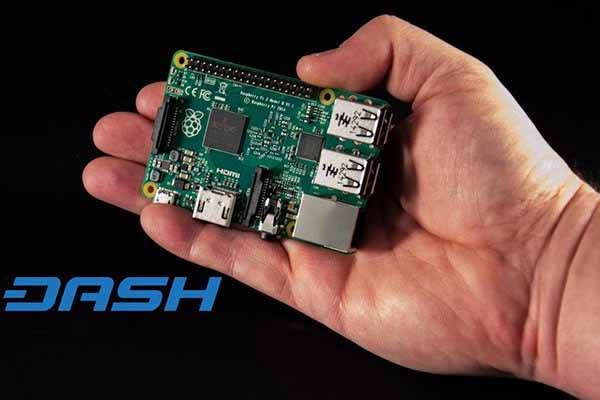
We interviewed two current Masternodes operators about their costs, setups, and recommendations. Dash Talk members Mangled Blue and Fuzzyduck both use the Raspberry Pi 2, which costs about US$40. They’ve added to it an $US8 microSD card (8GB).
Mangled Blue says that he also used an HDMI cable, HDMI monitor, a USB keyboard, and a USB mouse. He indicates that it’s possible to use a cell phone charger for power, or a microUSB-b to USB cable. Lastly, he connects his Pi with an Ethernet cable to his Internet modem, as he doesn’t recommend using Wi-Fi, though he concedes that it could work. He adds:
“I might not know every little detail about DASH or other cryptos, but having a Masternode keeps me involved. It also forces me to learn something new – I knew nothing about Linux this time last year.”
Fuzzyduck says that the Raspberry Pi 1 only had 512MB of RAM, which may not have been enough to run a Masternode. But the Raspberry Pi 2 – boasting a full gigabyte of RAM – does the trick. He says:
“My Pi2 is running super-stable at the moment, and I hope it remains this way for the coming versions. I would like to see more people just try it.”
Collateral
A collateral of 1,000 Dash is required to run a Masternode. This amount remains in the user’s possession (no private keys are transferred to anyone else). The user can rescind their Masternode status at any time by reclaiming their collateral.
The collateral scheme is designed to make a malicious takeover of the network (a “51 % attack”) cost-prohibitive for an attacker. It also has a side benefit of stabilizing Dash’s price, making it more attractive as a currency.
Interested in running a Masternode, but don’t have the full collateral amount? Not a problem. “Even if you don’t have the 1,000 Dash required, we can find you people to pair up with – that’s how I got started,” says Mangled Blue. “You’ll find a lot of good info and people in the forums to get you up and running.”
Earnings
“After running the Masternode stable for months now, I can totally say it already paid for itself for sure!” says Fuzzyduck. “Current price is US$3 per Dash. My Pi2 cost about US$35. I earn three Dash every four days. Do the math.”
And the payout isn’t the only perk for Fuzzyduck. He continues, “Since we are all technerds, we love to tinker with hardware and software – just for the fun of it! If I can do it, you can too.”
Proper Security & Risk Management
Dash Talk user Flare chimed in on security. He says:
“Running a publicly accessible host always requires security measures – the same security rules which apply for a VPS also apply for a home-run Pi (e.g. enable firewall and disable remote root login).”
And in the event that your home network is breached, your 1,000 Dash collateral is still safe, as neither a Pi nor a VPS ever stores your private keys.
Fringe BenefitsA Dash Masternode does more than just provide paid services to the network (namely the hugely important Darksend and InstantX). Each new node also adds to Dash’s decentralization – a key component for any peer-to-peer operation that aims to achieve resilience and staying power.
Just how decentralizing are Dash’s Masternode incentives already? Crunch these numbers: Bitcoin’s market cap is nearly US$4 billion, and it runs on 6,000 nodes. In contrast, Dash’s market cap is only US$17 million – a mere half a percent of Bitcoin’s market – but it runs nearly 50% of the nodes at 2,650 and counting.
Head on over to Dash Talk’s forums to post your questions about becoming a Masternode. Then check out Fuzzyduck’s detailed guide “How to Run a Dash Masternode on Raspberry Pi” to get started.
Where To Spend Dash?
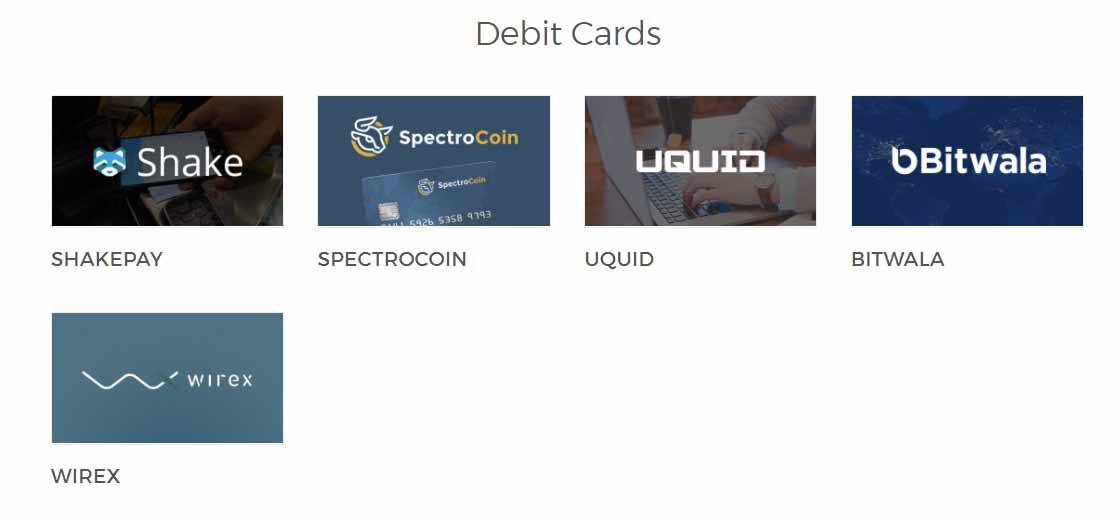
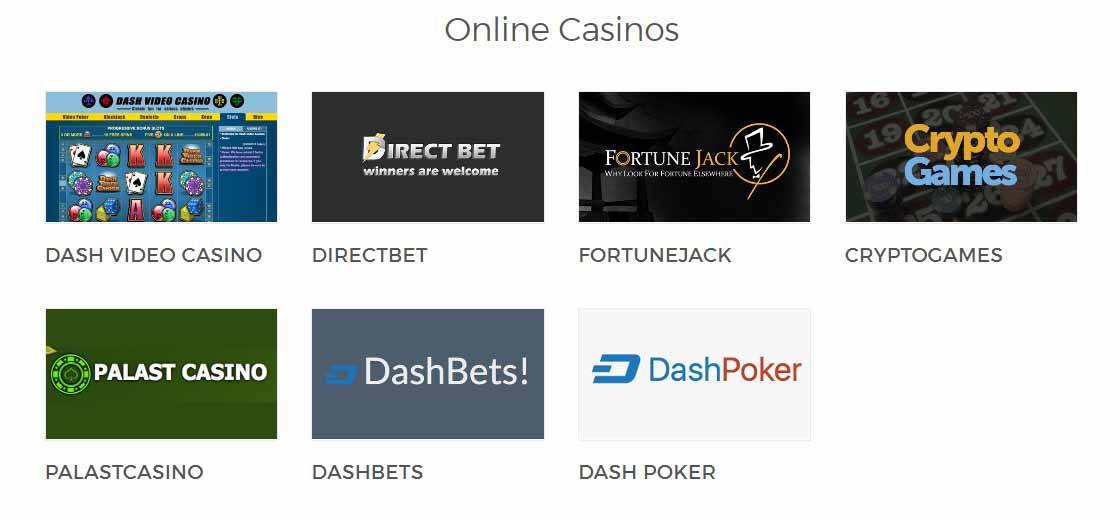
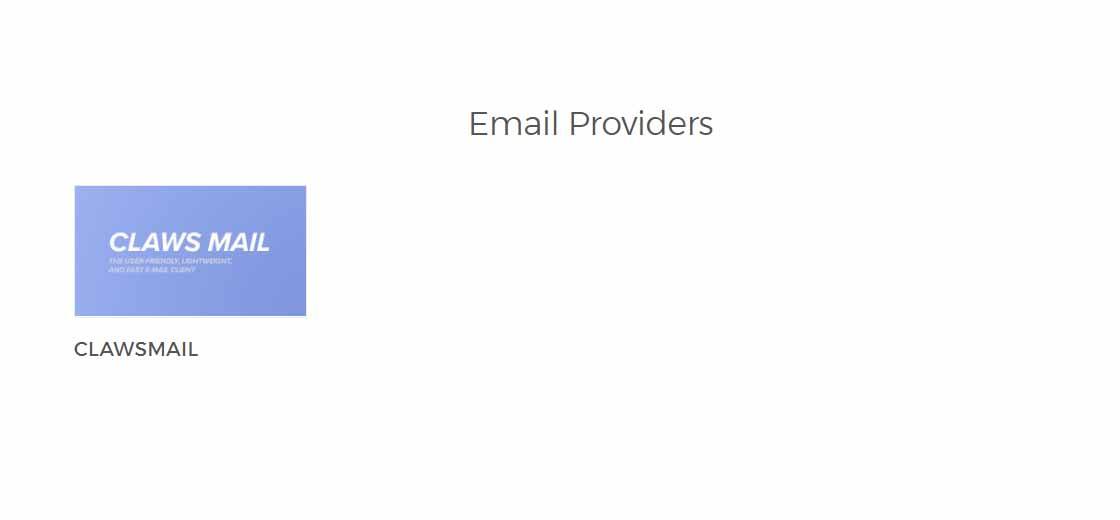
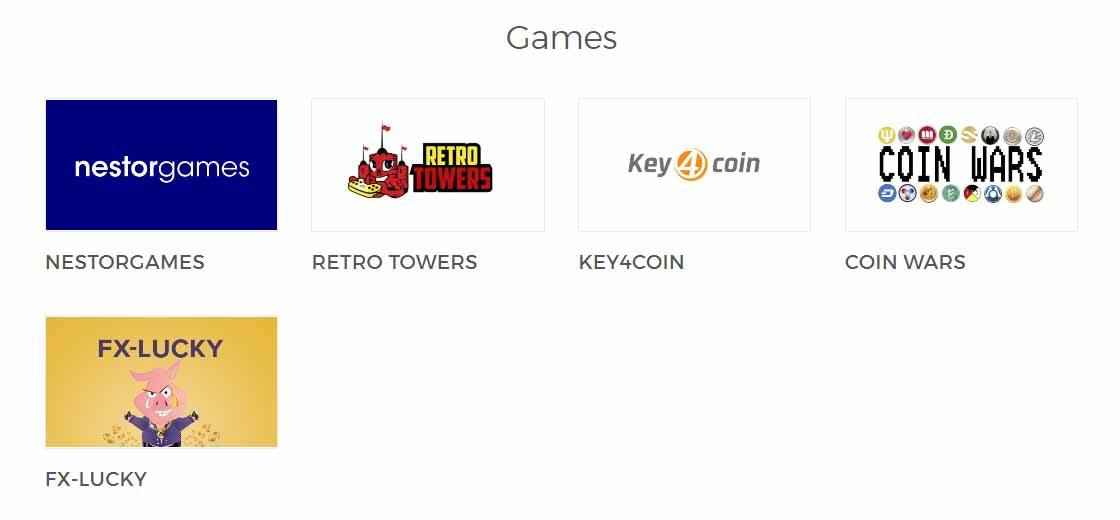
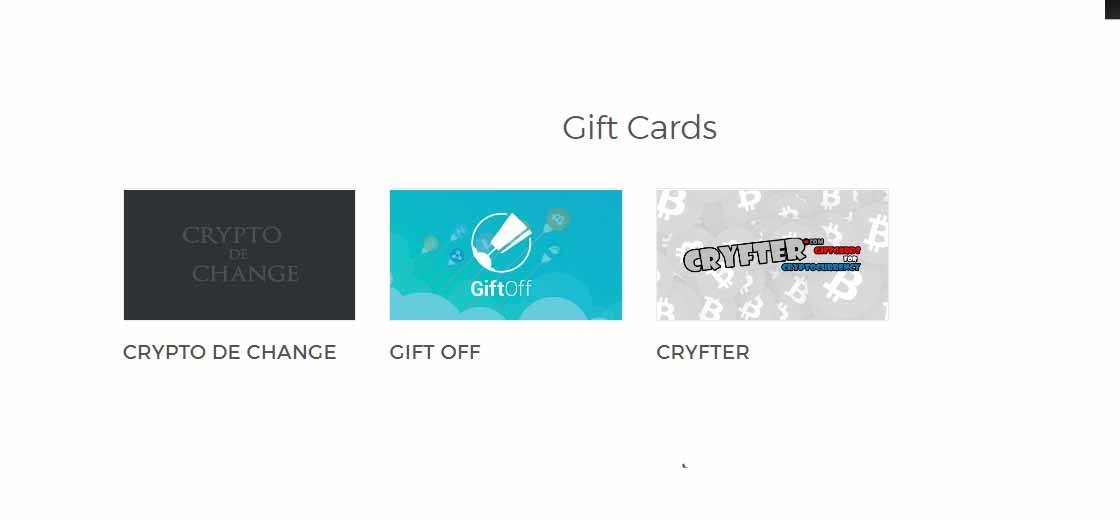
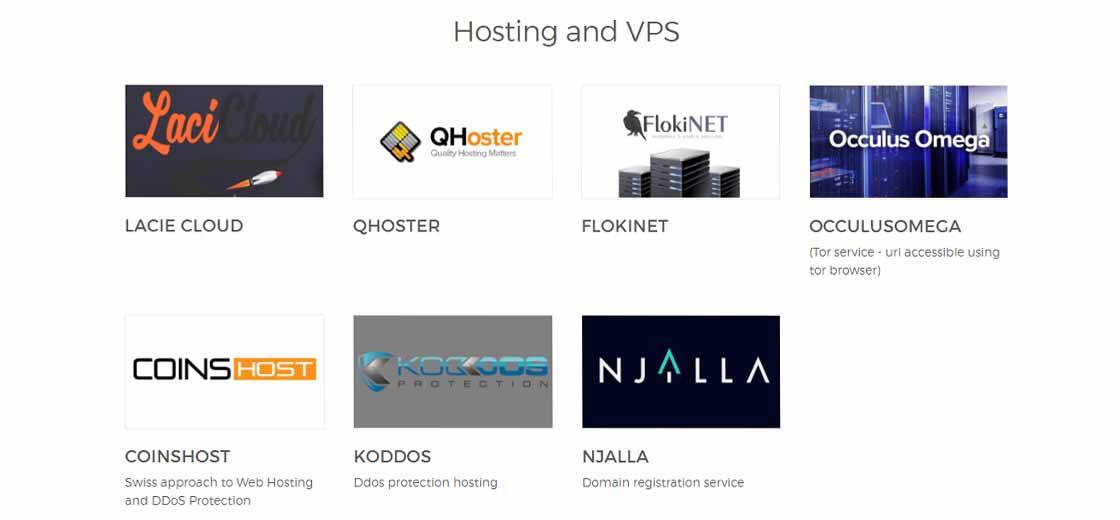
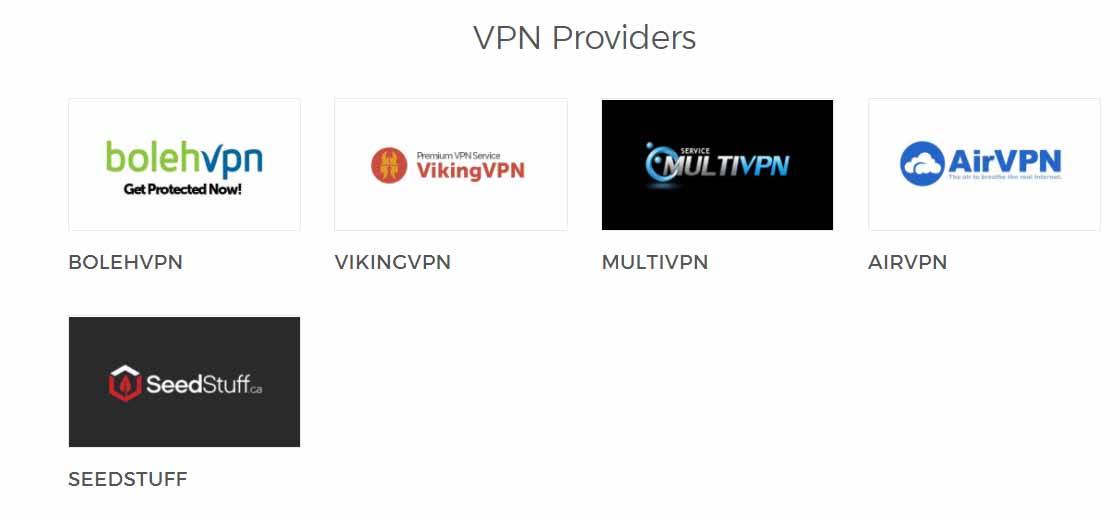

What Is Dash Mining?
Dash uses a special algorithm called X11 for the proof-of-work. X11 is one of the innovations introduced by Dash and has been widely adopted in the cryptocurrency community since its launch.
The characteristics of X11 make it very unlikely that ASICs will be developed to mine it, at least in the short term.
Mining in the context of cryptocurrency such as Dash refers to the process of searching for solutions to cryptographically difficult problems as a method of securing blocks on the blockchain. The process of mining creates new currency tokens as a reward to the miner. Mining is possible on a range of hardware. Dash implements an algorithm known as X11, which the miner must solve in order to earn rewards.
The simplest and most general hardware available for mining is the general purpose CPU present in every computer. A CPU is designed to be versatile but offers less efficiency than a GPU, which is designed to rapidly calculate millions of vectors in parallel. While specific CPU instruction enhancements related to cryptography such as AES or AVX can provide a decent boost, GPUs offer a significant performance increase due to their multiple pipelines for predictable calculations of the type involved with mining.
Finally, ASICs can perform a single operation only. A number of X11 ASICs are now available on the market, which are quickly making CPU and GPU mining uneconomic due to the increased difficulty of hashing arising from the rapidly increasing hash rate. The result is a currency which is more secure against brute force attacks on the Dash blockchain.
Mining versus Masternodes
Dash, like Bitcoin and most other cryptocurrencies, is based on a decentralized ledger of all transactions, known as a blockchain. This blockchain is secured through a consensus mechanism; in the case of both Dash and Bitcoin, the consensus mechanism is Proof of Work (PoW). Miners attempt to solve difficult problems with specialized computers, and when they solve the problem, they receive the right to add a new block to the blockchain. If all the other people running the software agree that the problem was solved correctly, the block is added to the blockchain and the miner is rewarded.
Dash works a little differently from Bitcoin, however, because it has a two-tier network. The second tier is powered by masternodes (Full Nodes), which enable financial privacy (PrivateSend), instant transactions (InstantSend), and the decentralized governance and budget system.
Because this second tier is so important, masternodes are also rewarded when miners discover new blocks. The breakdown is as follows: 45% of the block reward goes to the miner, 45% goes to masternodes, and 10% is reserved for the budget system (created by superblocks every month).
The masternode system is referred to as Proof of Service (PoSe), since the masternodes provide crucial services to the network. In fact, the entire network is overseen by the masternodes, which have the power to reject improperly formed blocks from miners. If a miner tried to take the entire block reward for themselves or tried to run an old version of the Dash software, the masternode network would orphan that block, and it would not be added to the blockchain.
In short, miners power the first tier, which is the basic sending and receiving of funds and prevention of doublespending. Masternodes power the second tier, which provide the added features that make Dash different from other cryptocurrencies. Masternodes do not mine, and mining computers cannot serve as masternodes. Additionally, each masternode is “secured” by 1000 DASH.
- Overview - Table of Contents
- What Is Dash?
- Getting Started With Dash
- How To Get A Dash Wallet?
- Dash Resources
- How To Buy Dash?
- How To Earn Dash?
- Where To Spend Dash?
- What Is Dash Mining?
- Latest Dash News
Those DASH remain under the sole control of their owner at all times, and can still be freely spent. The funds are not locked in any way. However, if the funds are moved or spent, the associated masternode will go offline and stop receiving rewards.
CPU Mining
OK everyone, its time to hash the Dash using your trusty CPU cores to find X11 solutions on the Windows platform! Please note that the prevalence of GPU and ASIC miners mean that this is highly unlikely to be profitable! Since this is the case, the software in this guide has not been updated in several years, and is intended for experimental purposes only.
This is a fairly simple procedure and examples will be given in order to achieve the fastest possible hash rate for your CPU, but remember that more optimized miners do exist, so we advise you to keep an eye out on mining sites such as these in order to keep up with the latest information and releases.
Mining Software
You will need software, a good starting place is this:
https://github.com/elmad/darkcoin-cpuminer-1.3-avx-aes
This software depends on your CPU supporting the AES-NI and AVX instruction sets. You can use CPU-Z to check if this is the case for your CPU:

If your CPU does not support AES-NI and AVX, then you can try more generalized software which does not require specific instruction sets, such as these:
https://github.com/ig0tik3d/darkcoin-cpuminer-1.2c
https://github.com/tpruvot/cpuminer-multi
Our goal here is to choose mining software that supports the maximum possible instruction sets available on your CPU, and then try to increase the hash speed.
Once you have made your choice, click Releases and download and extract the zip file. The folder should look something like this:

The different *.exe files indicate which specific processor optimizations they support.
Mining pools
You must join a team of people known as a pool in order to find and solve blocks. A common choice of pool runs the P2Pool software, and you can find a list of Dash P2Pools here.
http://www.p2poolmining.us/p2poolnodes/
Other pools include:
http://www.zpool.ca/
https://dash.suprnova.cc/
https://www.nicehash.com
Choose your pool based on the ping latency, uptime, fee, users, etc. Please support P2Pool nodes if possible, since they keep mining decentralized and protect the network from 51% attacks!
You will also need to create a Dash address to receive your payout. To do this in Dash Core wallet, see here.
Configuration
Keep all your mining files in a single folder. In this example we will work from the Desktop. The node selected for this example is from the p2poolming.us list and is located in China:
http://118.184.180.43:7903/static/
Next, open Notepad and type in on one line the command we will use to start the miner, followed by pause on the second line. The general format is as follows:
minerd -a algorithm -o url -u username -p password -t threads
pause
Where:
minerd = the executable miner daemon file you choose to use
a = algorithm, which is X11 for Dash
o = URL of your mining pool, including the protocol and port
u = username, usually the Dash receiving address of your wallet or worker
p = password, can often be set to x
t = number of threads used
pause = keeps the window open in the case of errors
For the CPU in the example above, the command may be:
minerd-avx-aes-sse2-sss3.exe -a X11 -o stratum+tcp://118.184.180.43:7903 -u XwZRjo1f6gmq3LCv7X1Hi5h3NkvDMHvu8G -p x -t 8
pause

Click File, then Save As. Change Save as type to All Files, then type the file name as startminer.bat and save it in the same folder as the unzipped minerd files.
Tips
- Reduce the number of threads for added desktop usability and heat reduction.
- If the CPU temperature is too high, consider fitting a new fan and check that the heat sink thermal paste on the CPU is adequate.
- Tweak the processor clock speed for added performance using a motherboard controller like AI Suite for Asus motherboards. Reduction of CPU core voltage will result in lower temperature but increased instability.
- Try to select a pool that is nearby to reduce network latency. If the node appears slow, switch to another location.
Please distribute the hashing power globally to different pools to avoid forking.
GPU Mining
This guide consolidates several other guides on how to use your GPU (the processor on your graphics card) to mine Dash using the X11 algorithm on Windows. Please note that the growing market for ASIC miners means that this if probably not going to be profitable! A lot of the software and binaries described here also have not been updated for several years, so this guide should be used for experimental purposes only.
This guide will cover the process of downloading and configuring the mining software, followed by some suggestions for optimizations. This technology can change rapidly, so we advice you to keep an eye out on mining sites such as these in order to keep up with the latest information and releases.
Mining Software
As for CPU mining, a range of mining software is available for GPU mining. Most of it based on sgminer compiled with different optimizations specific to different hardware. A good approach is to identify your graphics hardware, then choose an appropriate build of sgminer. You can use GPU-Z to identify your GPU hardware:
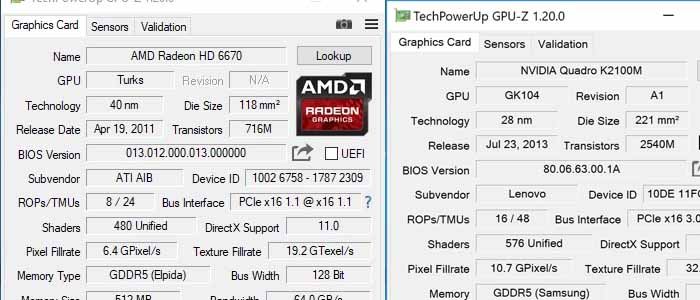
GPU-Z showing details for AMD Radeon Turks and NVIDIA Quadro GK104 class GPUs
Next, download the mining software. Most of these are based on the original sgminer, but this is not suitable for the X11 algorithm, offers no compiled binaries and hasn't been updated in years. We will describe using pre-compiled binary software maintained by newer developers only.
AMD
https://github.com/nicehash/sgminer/releases
https://github.com/dashminer/dashminer/releases (supports one pool only)
NVIDIA
https://github.com/tpruvot/ccminer/releases (focus on core application) https://github.com/sp-hash/ccminer/releases (sp-mod, optimized CUDA kernels for Windows) https://github.com/KlausT/ccminer/releases (similar to SP version, more clean)Download your chosen release and extract the zip file to a known location. The folder should look something like this:
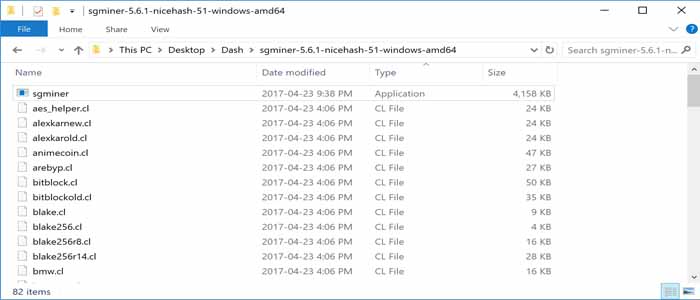
The sgminer file is the executable file, while the various files with .cl extensions define the various algorithms supported by sgminer. In this case, we are interested in the darkcoin.cl and darkcoin-mod.cl implementations of X11. Note that the name of the executable file may be different for miners with different optimizations, for example ccminer for NVIDIA cards.
Mining pools
Many people join a team of other miners, known as a pool, in order to find and solve blocks. A common choice of pool runs the P2Pool software, and you can find a list of Dash P2Pools here.
http://www.p2poolmining.us/p2poolnodes/
Other pools include:
http://www.zpool.ca/
https://dash.suprnova.cc/
https://www.nicehash.com
Choose your pool based on the ping latency, uptime, fee, users, etc. Please support P2Pool nodes if possible, since they keep mining decentralized and protect the network from 51% attacks!
You will also need to create a Dash address to receive your payout. To do this in Dash Core wallet, see here.
Configuration
Keep all your mining files in a single folder. In this example we will work from the Desktop. The node selected for this example is from the p2poolming.us list and is located in China:
http://118.184.180.43:7903/static/
Next, open Notepad and create the basic configuration. The general format is as follows:
{
"pools" : [
{
"url" : "stratum+tcp://pooladdress:7903",
"user" : "walletaddress",
"pass" : "x",
"algorithm":"darkcoin"
}
]
}
Where:
pools = defines a list of pools (in this case, only one) towards which the hashing power is directed
url = URL of your mining pool, including the protocol and port
user = username, usually the Dash receiving address of your wallet or worker
pass = password, can often be set to x
algorithm = hashing algorithm to use, in this case darkcoin (for historic reasons) or darkcoin-mod
For the pool above, the configuration may be:
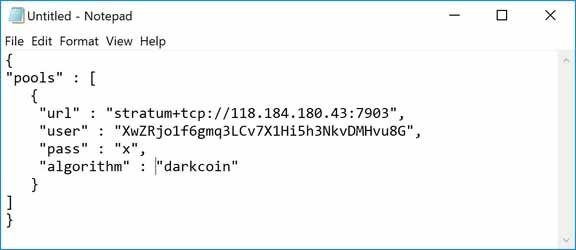
Click File, then Save As. Change Save as type to All Files, then type the file name as sgminer.conf and save it in the same folder as the unzipped sgminer files.
- Overview - Table of Contents
- What Is Dash?
- Getting Started With Dash
- How To Get A Dash Wallet?
- Dash Resources
- How To Buy Dash?
- How To Earn Dash?
- Where To Spend Dash?
- What Is Dash Mining?
- Latest Dash News
Tips
- Installing the latest display drivers can often improve performance. These can be found here for NVIDIA and AMD.
- If you have problems with old driver versions, try to use a Display Driver Uninstaller tool in safe mode to make sure there is no trace of previous versions.
- If you are feeling adventurous, you can try to overclock your GPU to squeeze out some more performance (at your own risk) using Afterburner. You can do this both by increasing the clock rate and decreasing the voltage to manage heat. Be aware of your maximum GPU temperature, anything above 90 °C risks permanent damage to your GPU.
- If you have a Crossfire setup, disable Crossfire in your ATI Catalyst settings or things will be funky.
- Changing the graphics driver version can influence performance. Some report for AMD cards suggest that Catalyst 14.7-RC3 may offer increased performance.
- You can also try mining under Linux, or compiling your own mining binary from source with specific optimisations for your hardware under either Windows or Linux.
Latest Dash News
Dash is Now in Public Beta on KeepKey Wallet

Dash is a welcome addition to KeepKey’s cryptocurrency platform. Not only can KeepKey users safely store Dash on the device, they can now do it in the KeepKey client itself. Dash, the seventh largest cryptocurrency by market cap, is the latest asset you can protect under the KeepKey security umbrella. Dash joins the likes of bitcoin, litecoin, dogecoin, and ethereum.
KeepKey’s support for Dash also extends to ShapeShift. With the addition of Dash, users can now exchange 20 unique currency pairs in the KeepKey client!
Releasing 12.1 version of Dash
The new binaries, along with documentation, will be available in www.dash.org.
Mining pools
The information needed to the upgrade is available at https://dashpay.atlassian.net/wiki/display/DOC/Mining+pools
Masternodes
New hardware requirements and upgrade guides will be available at https://dashpay.atlassian.net/wiki/display/DOC/Masternode+Update
Users / Exchanges
Basic upgrade guide will be available upon release.
Support about the update
Should you have any question about the update, we recommend either:
-#dash_support_desk channel at the Dash Nation Slack (public, cummunity-driven Slack, you can sign up here) -Official forum : /forum/topic/12-1-support.125/
